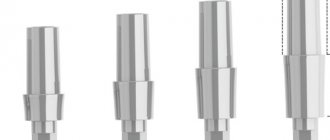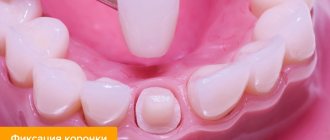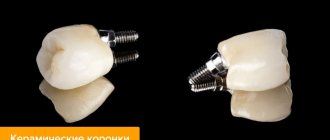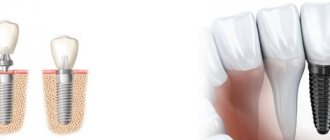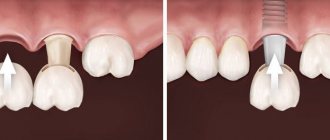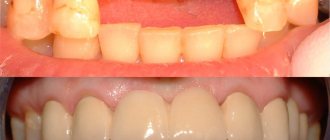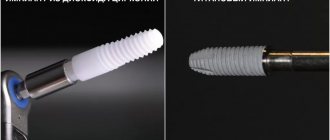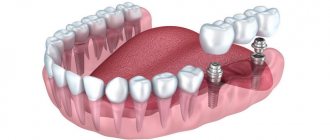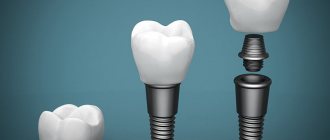Home > Dentistry > Orthopedics > Individual abutments
Grigory Georgievich Kyalov, chief physician of NKclinic, answered in detail the most popular questions about individual abutments and aspects related to their selection and use.
Video by Grigory Georgievich Kyalov: Individual abutment part 1
— Hello, Grigory Georgievich! Let's start with the obvious question: what is an abutment?
- Hello. An abutment is a superstructure that is used in the prosthetics of dental implants, both temporary and permanent structures. Simply put, it is a support that serves to hold the contour of the soft tissue around the implant and the crown itself. The specific type of abutment is always selected for each individual case. Many factors are taken into account, which I will also talk about.
— What types of abutments exist?
— Abutments are divided into two types: standard, with a unified connection and individual. Standard abutments are usually offered for permanent or temporary prosthetics by specific manufacturers of the implant system. Accordingly, they are suitable for the implant system that is already installed in the patient. NKclinic works with the most famous Renova Keystone and Nobel Biocare systems.
— What are the advantages of standard unified abutments? Are they used often?
- Undoubtedly. Standard unified abutments fully comply with the quality standards of the manufacturer: they have an ideal connection with the implant, are distinguished by high precision of fit and homogeneity of structure. Professional machines for their production are expensive equipment that only really large production facilities can afford. After creation, each abutment undergoes X-ray inspection. The strength and quality of such structures is comparable to the strength and quality of the implants themselves. But still, we use them extremely rarely today.
- What does this have to do with?
— The fact is that due to the technological features of manufacturing, standard abutments have limited options for inclination, width and thickness, and this does not always meet modern functional aesthetic requirements. Some time ago, the main problem of implantology was, in fact, the installation of an implant and its engraftment in bone tissue. Today, correctly installed implants take root in almost 100% of cases! Therefore, the emphasis has shifted to working with soft tissues, namely the gums. Around the implant we must create the contours of the future crown, reminiscent of a natural tooth. To achieve this, the gums must be high: at least 3-4 mm, and for the best result 5 mm, very dense, and immobile. The gums are a very changeable tissue that requires careful attention at the prosthetic stage. With strong physical impact, or when cement gets in while fixing the crown, inflammation develops, which will inevitably affect the bone structure. This in turn can lead to problems with the implant itself. That is why, following modern protocols, we almost always use exclusively individual abutments made of precious metals, titanium, and zirconium. This allows you to create certain conditions for fixing the crown, which will prevent cement from entering the thick layer of the gingival contour. Standard abutments, unfortunately, are not suitable for these types of prosthetics.
— How is the decision made on choosing the material from which an individual abutment will be made?
— Each case is considered separately and the choice is made based on the result we want to achieve. For example, if we are prosthetizing the anterior group of teeth and the primary task is to solve an aesthetic problem, then individual zirconium abutments are used. Firstly, they are closer in color to natural teeth. Secondly, the gingival contour accepts zirconium very well; it is absolutely non-reactive and does not cause any inflammation. We verified this by studying mucosal cells using an electron microscope: there are fewer infiltrating cells around zirconium than even around titanium.
Gold-containing custom abutments are a good option. Gold has excellent biological compatibility. But they are not always suitable due to the aesthetic component. It can be almost impossible to disguise the color of a metal abutment, especially if the prosthetic conditions are very limited.
— What are the conditions for prosthetics?
- For example, there is not enough space between the teeth. Or we are dealing with the frontal group of teeth, where the crown has a certain final thickness. The biological width of the tooth we make includes the strength of the ceramic, the strength of the abutment and its color coverage. Often we simply do not have the volumes that we can use. Therefore, in the aesthetic area, we often opt for zirconium abutments. If this is a chewing group of teeth, and the patient has highly developed chewing muscles, or has a tendency to bruxism or clenching, we use individual abutments, thereby maintaining the strength of the superstructure.
— How are custom abutments made?
— Zirconium and other custom abutments are now created using a digital method. This saves a lot of time. Previously, the process was carried out entirely manually. Now we only finalize the product with our hands. The dental technician and orthopedic doctor receive a 90% finished structure and do what the machine cannot do, individualize it for a specific case, adjust the ledges, polish, etc.
— Please tell us about these abutments. Which ones are better, from what materials are they made?
— We have our own experience working with each type of abutment, and, unfortunately, not all experience is positive. Solid zirconia abutment is used in some implant systems, but we are skeptical about it. In this case, even the inner part is cut out of zircon, which goes into the very neck of the implant. Zircon material is strong, but does not withstand fracture loads well. When, under the influence of the fashion for new things, solid zirconium abutments were often installed, complications occurred in the form of abutment fracture in the area of the implant neck. Therefore, we abandoned this technique.
It is much better if in the abutment the zirconium passes through titanium or through a precious alloy to the neck of the implant. There is one more point, zirconium is a very durable crystalline material and if it comes into contact with titanium, it begins to grind it down. Therefore, fixing solid zirconium abutments into an implant, especially on the chewing group of teeth, in our opinion, is a dubious technique. Therefore, in the transition part through which the zirconium is pulled, a gold-containing alloy must be present, or the base of the connection must be made of titanium, which makes it possible to neutralize the impact on the neck of the implant.
— Why is it so important to take into account all the nuances?
— Implant replacement may be required at any time. For example, a patient who has an implant has lost two adjacent teeth, but there is no opportunity to place two implants. Then we place one implant and make a bridge from the old to the new. This will require removal of the abutment. And if the neck of the implant is damaged, the new system will not be as durable. We always try to think ahead and ensure years and years of flawless operation of the systems we install.
— They say that not all experts approve of glued zirconium abutments. In your experience, can they be trusted?
- We never had problems with them. In our practice, there is not a single case of abutment unsticking. If you do everything according to technology, taking into account all the physical properties of the materials, problems will not arise.
— What does sticking or gluing an abutment mean?
— When manufacturing a glued individual zirconium abutment, we use a titanium base, to which the zirconium is attached using a certain gluing method. We achieve high retention of the zirconium abutment body and titanium base, which we secure using the latest techniques. Modern bonding systems create an active layer on the surface of zirconium and titanium, allowing for high-quality gluing of these materials. Bonding, in turn, can withstand enormous loads. This is very important for chewing function. We achieve high retention of the zirconium abutment body and titanium base.
—What material are crowns made of, what is important to consider when choosing?
When making crowns, we use various restoration materials, which are selected for specific clinical situations.
Crowns can be either frame-based or frameless. As a rule, milled cobalt-chrome, gold alloy or zircon are used as a frame. One or another type of dental ceramic is applied on top of the frame. We use this type of crown for discoloration.
Frameless structures include all-ceramic crowns, which are made from feldspathic ceramics, lithium ceramics, or solid zircon. As a rule, these crowns are cemented using the classical method onto an individual abutment. Depending on the possibility of dynamic changes in the patient’s bite, we select a more suitable type of ceramic for prosthetics.
Prosthetics is a multi-stage procedure, which is not very convenient for the patient. It is extremely uncomfortable to remain without a tooth throughout the entire period: from installing an implant to making and installing a permanent crown. NKclinic have a practice of including immediate loading? Do custom abutments help with this?
No. Individual abutments are used only when working with dental implants integrated into the bone tissue at the stage of dental prosthetics. In the case of implantation in an aesthetically important area, when we use the immediate loading technique, crowns are made with a transocclusal fixation method. This method is applicable only for simultaneous loading, as it allows further dynamic observation of the patient without resorting to rough influence on dental implants, which is very important during the period of their engraftment. The transocclusal method of making crowns allows you to program the future gum contour for the further use of individual abutments.
Immediately after installing dental implants, we use factory-made temporary titanium abutments, which allow us to attach a structure that imitates natural teeth to them. Two manufacturing methods are commonly used: direct and laboratory.
Direct - the model of future teeth in the area of planned implantation is formed in advance. Using it, a silicone key is made, which helps to transfer an exact copy of the teeth after installing implants into the patients’ mouth. This method allows you to get results very quickly, on the day of surgery, but requires compliance with certain rules to avoid infection of the fresh wound surface.
Laboratory - in this case, crowns are not made in the patient’s mouth, which is closely associated with the production process, time costs and quality control. Today, the digital protocol for making crowns for immediate loading is a priority in our clinic. Using sterile scan markers and an intraoral scanner, in 15 seconds we obtain a digital impression of the jaw with the exact position of the implants and the level of the gingival contour. We model the crowns in a special digital program and within 20 minutes we obtain them using a 3D printer. After appropriate treatment, the crowns are fixed in the oral cavity.
This way our patients are not left without teeth, even for a short time, especially in an aesthetically important area!
— What are the prices for individual abutments?
Prices for individual abutments at NKclinic start from 25,000 rubles. Each case of dental treatment is purely individual and the final cost is determined after consultation.
Types of abutments used for dental implantation
Depending on the manufacturing method:
- Standard - produced on the basis of a universal template. There are several options for length, diameter, and angle of inclination. During production, the personal parameters of the fabrics are not taken into account, so the aesthetics of the restoration is not at a high level. Standard suprastructures are divided into: gingival former, angular, straight, spherical.
- Individual - modeled based on the patient’s impressions in the CAD/CAM program and made by a dental technician on a milling machine in a single copy. Such adapters well support the contour of soft tissues and prevent cement from leaking under the gum.
Fixation methods
The strength of the entire orthopedic structure depends on how all its component elements are secured. To ensure that the restored tooth does not become loose and serves the patient for many years, the prosthesis must be securely fixed by connecting it with an abutment to the implant. There are several mounting options for this product:
- Using cement.
- Screw fastening.
Nowadays, the second method of fixation is increasingly used, because the first has its share of risk. If the cement mixture gets on the gum, irritation and development of peri-implantitis may occur, which will require reinstallation of the implant itself.
How is it different from standard
An individual abutment, unlike a regular one, is not a round stump, but a full-fledged tooth stump, similar to a natural crown sharpened for a prosthesis. Due to the fact that the standard adapter is much narrower, during fixation, excess cement flows into the space between the implant and the gum. An error can provoke tissue inflammation and rejection of the titanium root in the early or medium term. Such consequences can be easily prevented by installing an individual design.
«
Abutment replacement and manufacturing companies
An implant-abutment-crown is a structure consisting of several elements that, for a number of reasons, can break or fail. Replacing implants requires invasive surgery, but if you have a broken abutment, installing a new one is easier.
Abutments for implants (as well as additional orthopedic components) are produced by the same manufacturer. That is why, in order to quickly find a replacement, we recommend installing implants from well-known brands that have been around for more than one year. These do not necessarily have to be premium companies: today, economy class manufacturers are widely represented on the market, which, however, maintain an acceptable level of quality. If the doctor offers you products from new and unknown brands, be prepared for the fact that the company may cease to exist at any time, which will make it difficult to replace components.
Among the top companies, the most famous are Nobel Biocare, Straumann, Astra Tech, Ankylos, Xive. Budget brands of implants that you can definitely trust: Alpha Bio, MIS, Dentium, Osstem.
What are they made from?
Titanium
Titanium structures cope well with chewing loads and retain strength even with a wall thickness of 0.1 mm. They are distinguished by a wide range of applications and low cost. But titanium adapters have one serious drawback - they are visible through the gums, which reveals the artificial origin of the tooth. Therefore, they are usually used for the lateral parts of the jaw .
Zirconium dioxide (oxide)
Zirconium dioxide superstructures are virtually free of disadvantages. The material is endowed with similar optical properties to natural teeth - it has the same color, structure, and reflective ability. The smooth surface prevents the accumulation of bacterial plaque. Zirconium does not lose its original properties throughout its entire service life. Due to fragility due to the small thickness of the walls, it is indicated for prosthetics of the frontal region.
Combined
Hybrid abutments are used for both posterior and anterior restorations. They are manufactured using a standard titanium base and a component milled from a single piece of zirconium dioxide. Then the zirconium and titanium are sandblasted and coated with a primer to improve their adhesive properties. After preparing the surfaces, the two parts are glued together with dental cement and take on the appearance of a solid structure. Composite glue or German Hotbond material can be used as a fixing agent.
When choosing suprastructures for permanent restorations, the thickness of the mucous membrane, the depth of the implant, and the prosthetic area of the jaw (frontal or lateral) are taken into account.
Price
Individual abutment, manufacturing price can vary from 5000 thousand and above. The final cost of installing the product depends on many factors, for example, premium brands will cost much more than economy segment products. At an appointment with a dentist, you can learn about all the features of dental implantation, prices for services and timing of the operation. Choose a qualified implantologist who will be focused on a successful result, and not on financial gain. The specialists of the A-medic clinic are always ready to answer your questions and help you decide on suitable orthopedic structures for dental restoration.
Manufacturing (modeling) technique in the laboratory
- After the artificial root has healed and the gingival contour has been formed, an impression coping is screwed onto the implant to take an impression .
- The impressions are sent to a dental laboratory to make plaster models .
- The finished model is scanned and transferred to a computer program for modeling.
- An abutment is cut out of a solid block blank using a computerized machine using CAD/CAM technology .
»
General overview
An abutment in dentistry is an element that connects two main parts of an implant structure - an intraosseous rod and an artificial crown.
The abutment is installed on the implant only after its complete osseointegration , i.e. several months after the implantation operation. This product can also be a support for placing fixed-type prostheses.
Different materials are used in the manufacture of abutments. Based on the task, installation location and characteristics of the jaw bone, models of different parameters and configurations are produced. The variety of products allows you to select the optimally suitable element for each clinical case.
A distinction is made between standard models and custom-made ones. Standard products are produced according to a single template and come complete with an implant structure.
Individual elements are made exactly according to the impression created from the patient’s jaws. These models are more expensive, and in comparison with standard products they have a number of undeniable advantages.
All types of abutments (both standard and individual) are divided into types:
- Angular. They have different angles of inclination for easy fixation of the implant in the desired direction. Thanks to this design, artificial teeth fit harmoniously into the dentition and look natural and aesthetically pleasing.
- Direct. The most commonly used models in frontal prosthetics are used in a standard two-stage procedure.
- Ball models are needed to secure removable dentures.
- Standard. Budget adapter option. They have several lengths and sizes.
- Temporary (gum formers). They are placed on the implant immediately after its implantation. They are used to prevent infection, accelerate healing, tissue formation, and protect the structure from food particles getting inside.
Installing an abutment is a surgical procedure, but as opposed to implanting an implant, it is simpler, faster and more painless.
Technique for manufacturing removable dentures on mini-implants and the material used in production.
Come here if you are interested in the prices of dental prosthetics on implants.
At this address https://zubovv.ru/implantatsiya/metodiki/odnomomentnaya/novaya-ulyibka-v-odin-den.html we will discuss the pros and cons of one-stage dental implantation.
Reviews
Only the doctor decides which abutment model will be placed, basing his decision on clinical indicators.
A properly selected connecting element determines the strength of the prosthetic structure itself, the degree of its functionality, comfort and operating time.
You can share your position regarding the advisability of installing individual adapters and talk about their main characteristics by leaving a comment on this article.
If you find an error, please select a piece of text and press Ctrl+Enter.
Tags abutment implantation
Did you like the article? stay tuned
No comments yet
Basic connection types
- internal hexagon: the end part of the component has the shape of an external hexagon, while the hole in the implant is made in the form of an internal hexagon. The adapter is equipped with a conical part, which allows for a strong connection and minimizes the risk of unwinding. The depth to which the abutment is installed inside the implant depends on the length of the latter,
- external hexagon: in this case, the connecting part has the shape of an internal hexagon, and the entrance hole of the implant is external. This design is called the “Branemark system”. Currently, this option is used less frequently than an internal join, because it is less reliable, because the abutments do not fit inside the implant cavity,
- internal three-channel connection: the connecting part of the implant and abutment may have a non-standard shape. For example, Nobel Replace Platform Shift systems offer a three-channel connection, that is, the structural parts are attached to each other using connecting elements in the form of an internal and external trihedron.
On a note! Today there is another type. Currently, single-component implants, that is, combined with an abutment, are actively used for one-stage implantation.
Possible complications
The most serious complication is implant rejection. It is accompanied by inflammation, pain and fever and requires urgent medical attention. In addition, the following complications may be present.
- Premature destruction of sutures, which provokes bleeding. To avoid it, it is important to follow a diet and not load the jaw during the recovery period.
- Severe growth of soft tissue. The problem requires urgent installation of a gum former, so you need to consult a doctor as soon as possible.
- Unreliable fixation of the crown. Most often caused by a violation of the abutment thread, which is a consequence of a manufacturing defect or installation defect.
- Implant loss. Possible due to excessive load or force.
It is important to know! You should not try to straighten or insert the implant yourself. In case of any damage, bleeding or inflammation, you should immediately consult a doctor.
Features of care
When an abutment is placed, it usually takes some time for the injured tissue to heal - after all, the gum is cut, the plug is removed from the implant, and a crown component is placed on top. But in some cases, when the abutment is fixed immediately, only general recommendations for the postoperative period can be identified.
At the first stage, regularly rinse your mouth with special solutions with an antiseptic effect. A couple of days after the procedure, you can start brushing your teeth with a soft brush - but this issue should be discussed in advance with your implantologist.
